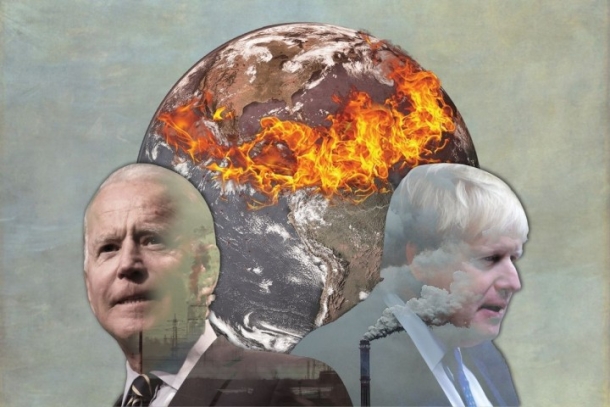On Sunday 31 October, negotiations will officially open for COP26, the latest UN Climate Change Conference. Hosted in Glasgow, Boris Johnson will welcome heads of state from around the world to commence two weeks of negotiations, panel-discussions, and press-conferences. Business leaders will also be present to present their ideas on tackling climate change.
Under pressure from events, the ruling class and its representatives have been putting the issue further forward on their agenda. Climate change has moved from a distant threat, to a current crisis. Even the most developed parts of the world are already experiencing climate disasters. This year in New York and in parts of Germany we have seen devastation caused by severe floods of such severity that they were once regarded as 1-in-100-year events. These are set to become common occurrences. This has economic and political implications that the ruling class can no longer afford to ignore.
For this reason, there is a lot of hype around the upcoming COP26 summit, but we have seen this hype before. In the mainstream media COP21 was celebrated as a turning point in the struggle against climate change. The general scientific consensus is that in order to avoid irreversible and unliveable consequences, the global temperature must be limited to an increase of 1.5C warmer than pre-industrial levels. This will require the global economy to have transformed to net-carbon-zero by 2050. These were the targets adopted in 2015 by the Paris Agreement at the United Nations COP21 summit.
While some are placing all their desperate hopes on these international pledges and summits, others see it as too little too late. Talk is easy, but what is needed is decisive action. The United Nations, however, is merely a glorified talking shop. It cannot force the hand of the world’s leading economic powers, which have conflicting interests.
Geopolitics and protectionism
Geopolitical tensions have made it hard enough for the representatives of capital in their various nation states to even come to a vague agreement on targets, let alone practical policy.
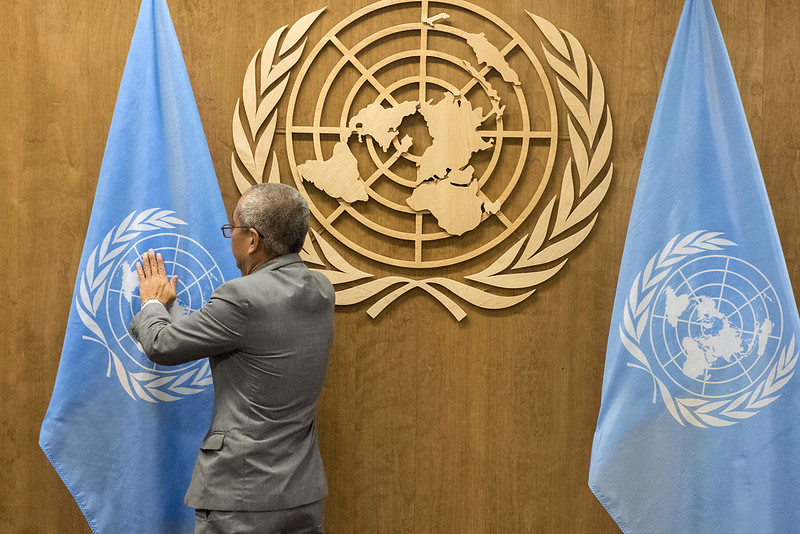 The United Nations is merely a glorified talking shop. It cannot force the hand of the world’s leading economic powers / Image: United Nations Photo, Flickr
The United Nations is merely a glorified talking shop. It cannot force the hand of the world’s leading economic powers / Image: United Nations Photo, Flickr
The main reason that the Paris Agreement’s targets were hailed as a breakthrough, was the claim that Barack Obama, Xi Jinping and Vladimir Putin, for the good of people and planet, had managed to rise above the imperialist rivalry between the world's three main economic powers. This illusion was unceremoniously shattered exactly one year later with the election of Donald Trump who campaigned on a promise to withdraw from the Paris Agreement; a promise on which he delivered. This exposed the bitterness of the trade war between China and the US in particular. It was not merely a blip resulting from Trump’s volatile character. The stagnation in the world market since 2008 has been a driving force for protectionism that has affected all the major imperialist powers
The collapse of COP21 and the subsequent proliferation of protectionist tendencies have demonstrated how fragile these promises and targets really are. Any talk of a global plan to implement them is downright meaningless. Private property and the nation state, inherent features of the capitalist epoch, are fundamental barriers to a long-term global plan of production for human need. The United Nations’ ‘Race to Zero’ campaign document, launched in June 2020, expresses this quite succinctly:
“Breakthroughs cannot happen if individual entities work in isolation from one another. The challenges of competition and inertia often deter ambition, where individual actors cannot make the first move without putting themselves at a distinct disadvantage in the near term.”
However, the UN is a tool of the major capitalist powers, to which it owes its very existence, and it is not able to look beyond the capitalist system for any solutions. Without wanting to completely throw in the towel, it must therefore resort to wishful thinking:
“The transition to net zero will occur through exponential change. We know this because it has happened before in every major industrial disruption – it will happen again with decarbonization. Technologies and new markets often grow on exponential curves, rather than in straight lines …”
“… Different actors - across sectors, geographies and economies - start to support the transition, and the positive feedback between them further raises confidence and increases demand and investment along every stage of the value chain, making it systemic.”
The UN can do no more than hope for a long period of economic growth in the world economy. And they are hoping that a regulation here, a tariff there, will inspire the whole economy to revolutionise itself in a carbon-zero transition.
It is this attempt to solve the environmental crisis through market forces that has led us to the precipice we find ourselves on now.
Investment
As it stands, 84% of the world’s primary energy consumption still comes from fossil fuels. 73.2% of all emission in 2016 came from energy production. Only around 20% of final energy consumption is provided by electricity. Nothing short of a complete transformation of global infrastructure is required. On the basis of an international plan this would be entirely possible.
In 2019, the IEA (International Energy Agency) put together a report called Offshore Wind Outlook 2019. The report concluded that “With high-quality resources available in most major markets, offshore wind has the potential to generate more than 420,000 terrawatt hours per year worldwide. This is more than 18 times global electricity demand today.”
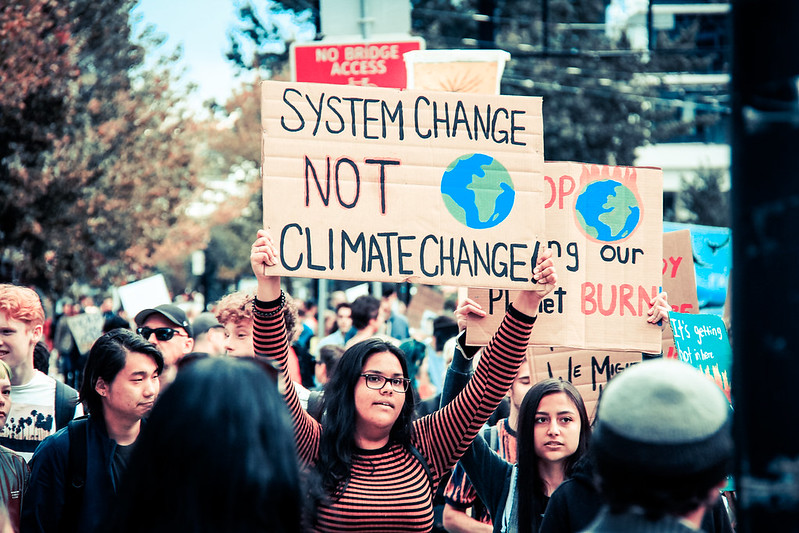 On the basis of capitalism, making the required transformation within the required time frame is impossible / Image: Chris Yakimov, Flickr
On the basis of capitalism, making the required transformation within the required time frame is impossible / Image: Chris Yakimov, Flickr
But on the basis of capitalism, such a transformation within the required time frame is impossible.
The current economic climate is distinguished by a chronic lack of investment. We do not have the time to sit and hope for an upswing in the global market. There has been some increase in investment in renewable energy, but the current level still falls far too short. According to the IEA, “In 2020, clean energy investments by the oil and gas industry accounted for only around 1% of total capital expenditure.” Although this is set to increase to 4% in 2021, “The $750 billion that is expected to be spent on clean energy technologies and efficiency worldwide in 2021 remains far below what is required in climate driven scenarios.”
The IEC has stated that “to reach net zero emissions by 2050, annual clean energy investment worldwide will need to more than triple by 2030 to around $4 trillion.”
At this rate, global investment would not even reach half of the required amount by 2030.
2020 was also supposed to be the first year of ‘Climate Financing’. Back in 2009 a pledge was made that between 2020 and 2025, the world's poorer countries would receive $100 billion every year from the world’s wealthier countries, for investment to tackle climate change. They fell $20 billion short in the first year.
The same problem exists in key industrial sectors too. Some pioneering projects here and there give a glimpse of the technological solutions that exist, but there is no sign of a genuine transition. In steel works for example, which contribute to around 8% of the world’s annual carbon emissions, enough investment could provide zero-carbon alternatives. This summer, at the cost of €1 billion, the first full-scale zero-carbon steel plant is underway, which will use green-hydrogen. This technology needs to be rolled out with the utmost urgency, on a global scale. There are two main reasons that this won’t be done. The first, is that a huge amount of capital is already invested in existing steel plants. Capitalists are not willing to move away from the blast furnaces they have poured so much capital into, before they get every last drop of profit that they can from them. Secondly, there is already excess capacity for the level of demand in steel, and so there is no real market for new investors to venture into. As explained in an OECD report in 2019:
“It takes years to plan, get permits for, finance, and build a steel plant, and once built, they can last for 25-50 years with proper maintenance. The current oversupply of steel plants, will also naturally serve to slow the development of newer, more innovative facilities.”
Even in the case of this new ‘zero-carbon’ steel-works, the question of profit could mean that it is all for nothing after all. The company, Arcelor Mittal, admitted in the small print that “Should green hydrogen not be available at affordable rates by the end of 2025, natural gas would be used to power the DRI furnace.”
Profit is the raison d’etre of capital. Faced with the choice of losing profit or polluting the planet, the capitalist must always choose the latter if they are to stay in business. The chaos of the market with its volatile fluctuations in prices is throwing up insurmountable barriers to tackling climate change.
The transition – chaos of the market
The capitalist class, spooked by regulations and public opinion, as well as the slump in demand during the pandemic, are withdrawing from fossil fuel investments, fearing for their profits. But this does not necessarily mean a corresponding increase in renewable energy investment. In short, they are withdrawing from the fossil fuel sector faster than they are able to provide clean energy. The resulting shortages have caused a supply shock, and soaring energy prices.
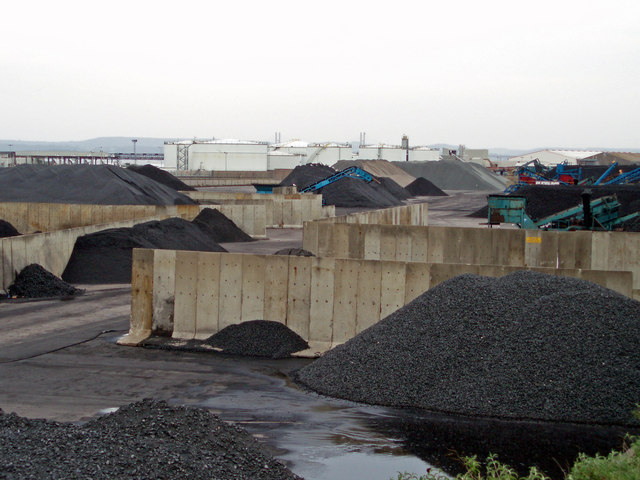 A transition to a green economy is not simply a matter of the scale of investment, but rather the manner of the transition. A holistic plan is required / Image: Sharon Loxton
A transition to a green economy is not simply a matter of the scale of investment, but rather the manner of the transition. A holistic plan is required / Image: Sharon Loxton
The rise in the price of fuel affects prices across the market, threatening generalized inflation. Instead of incentivising a move to green investment, it can have the opposite effect. Materials such as steel, copper, aluminum and lithium are essential for green infrastructure, but are currently very carbon intensive to produce. A last-minute frenzy of regulations and tariffs on carbon emissions is raising prices and disincentivising investment in these sectors too.
Referring to this problem as ‘Greenflation’, an article in the Financial Times explained that “trying to shut down the old economy too fast threatens to push the price of building a cleaner one out of reach.” For bourgeois policy makers, whatever way they turn, the market is riddled with contradictions that blow up in their face. An article in the Economist has highlighted that “there are grave problems with the transition to clean energy power… legal threats, investor pressure and fear of regulations have led investment in fossil fuels to slump by 40% since 2015.”
The result is economic turmoil, a step backwards for decarbonising, and a further increase in geopolitical tensions:
“Since May the price of a basket of oil, coal and gas has soared by 95%. Britain, the host of the summit, has turned its coal-fired power stations back on, American petrol prices have hit $3 a gallon, blackouts have engulfed China and India, and Vladimir Putin has just reminded Europe that its supply of fuel relies on Russian goodwill.”
As markets go into turmoil and geopolitical tensions increase, protectionist tendencies are being strengthened even further. Each national gang of capitalists is fighting to defend its own energy security, pouring subsidies into supporting “their” hydrocarbon companies and securing supplies of fossil fuels. Faced with the energy crisis, China has just announced it is going to build more coal power plants. It is therefore not simply a matter of the scale of investment, but rather the manner of the transition. A holistic plan is required. On the basis of capitalism, the transition cannot be a managed one.
The Return of Keynesianism
The world’s major players are now coming forward with their own disjointed investment plans, with some rhetoric around climate change weaved in.
The Chinese government declared it will reach peak emissions in 2030, to then reach net-zero by 2060, along with a pledge to withdraw overseas investment in coal power-plants. Currently the world’s number one producer of solar power, as well as the world’s number one polluter, Chinese industry paints a contradictory picture. It is responsible for over 50% of the world’s coal consumption. Some have more faith in China’s ability to decarbonise than other large economies, due to the heavy involvement of the Chinese state in economic matters. For the last decade or so, the Chinese state has undergone the most enormous programme of Keynesian state spending in history, and dictates to private investors in a way that, for a time, seemed to offer some semblance of state planning of the economy. But the Chinese economy is now running into deep contradictions. Debt has skyrocketed across the economy, with firms beginning to declare bankruptcy in the last year. Furthermore, it is facing large energy supply problems as a result of its attempts to regulate the energy sector, without actually owning it.
The picture in the United States is not a promising one either. The White House has reasserted its goal to decarbonise by 2050, but in the face of fuel shortages and rising prices, has called on OPEC to step up oil production.
The country is also set to burn more coal this year than last. To top it off, Biden’s $2.6 trillion investment plan has been slashed to less than a quarter in order to get it through congress. Unsurprisingly, the Clean Electricity Performance Programme (CEPP bill) is also being met by fierce resistance in the senate, by the staunchest representatives of oil and coal interests.
In China, the US, as well as in Britain and the EU, the main policy proposals are based on Keynesian spending, including financial schemes to incentivise investment in renewables and discourage investment in fossil fuels. But as has been explained above; just because investors are withdrawing from fossil fuels, does not mean they can be incentivised to invest the required amount in renewables. Ever since the latest economic crisis, cheap credit, and unprecedented ‘stimulus’ money has been thrown at the capitalist class, but chronic under-investment remains in the private sector.
The Green ‘New’ Deal
On the left, the Green New Deal is a dominant slogan, but it boils down to fundamentally the same question of the state trying to guide the market – and it suffers from all the same problems as the aforementioned ‘solutions’.
In the UK, ‘Labour for a Green New Deal’ has waged a campaign within the Labour Party and the trade unions for the adoption of their programme. The demands are largely progressive; “expanding public ownership”, “nationalisation of energy, water and railways”, “Well paid and unionised jobs”, “Green housing standards” etc. We could wholeheartedly support these. They are far better than the usual pro-market proposals about tradable carbon credits or green austerity which have been advanced by the pro-capitalist greens over the past decades, but we are serious about this being an existential crisis, we need to draw the necessary conclusions.
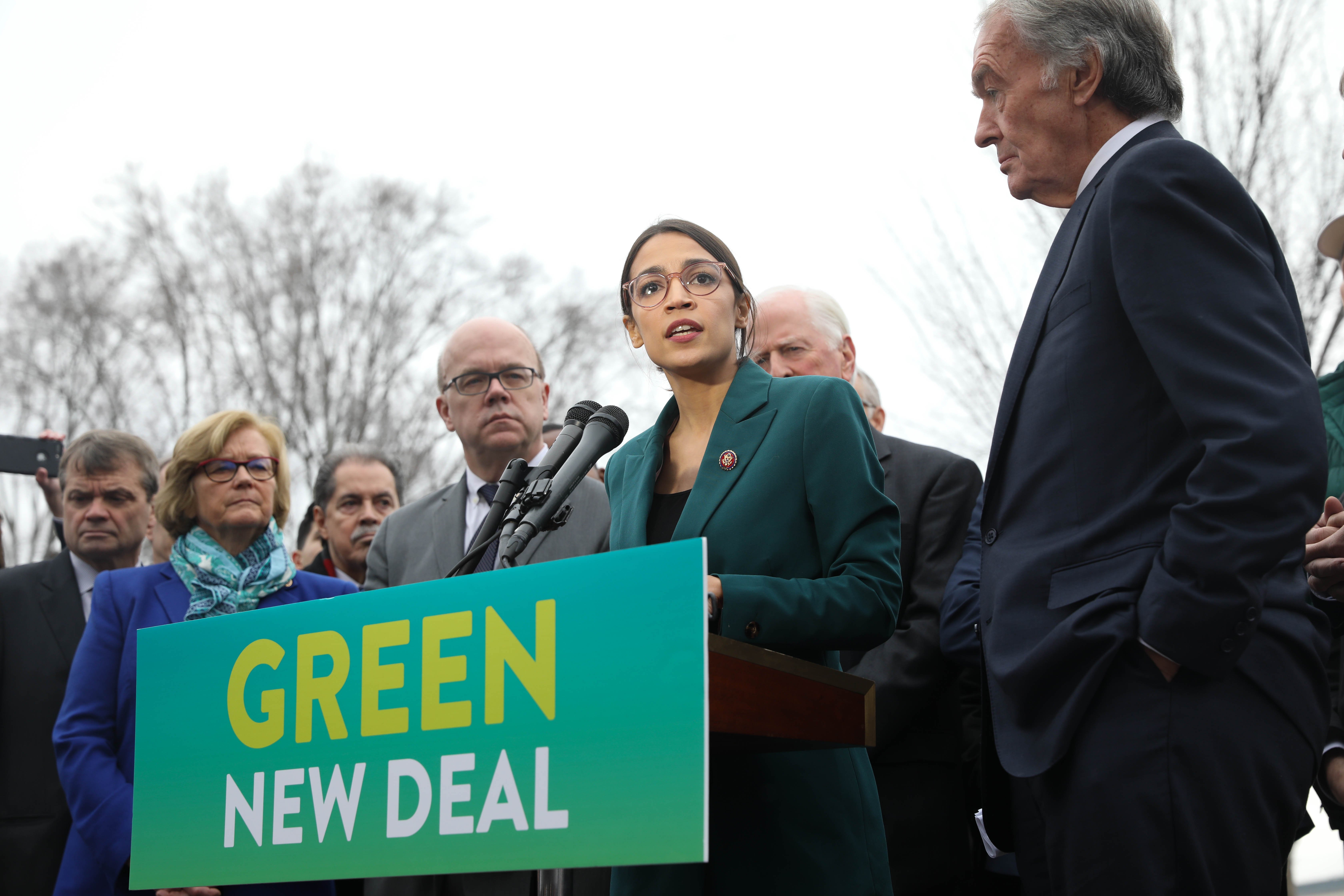 There is nothing fundamentally ‘new’ in the Green New Deal. Its name is deliberately drawn from Roosevelt’s 1930s plan to rescue US capitalism, and just like that old deal it fails to resolve the same old problems / Image: Senate Democrats, Wikimedia Commons
There is nothing fundamentally ‘new’ in the Green New Deal. Its name is deliberately drawn from Roosevelt’s 1930s plan to rescue US capitalism, and just like that old deal it fails to resolve the same old problems / Image: Senate Democrats, Wikimedia Commons
The calls for nationalisation are limited for certain sectors, to be run as an appendage to the market economy. But what about the other sectors, like steel? What about transportation? Sure, investment in trains is long overdue, but what is the plan for phasing out oil from cars and lorries? What about the production of batteries of all sizes, which will be a key part of making renewable energy possible? If we do not break with the anarchy of the market and the profit motive in making investment decisions, these questions will not be resolved.
There is nothing fundamentally ‘new’ in the Green New Deal. Its name is deliberately drawn from Roosevelt’s 1930s plan to rescue US capitalism, and just like that old deal it fails to resolve the same old problems. It suffers from the same limitations as Keynesian policies in general. Firstly, that capital will still dominate the global economy, and secondly, that the global economy is in a period of slump. Government spending can’t create a period of capitalist growth. The chaos of the market, volatile prices and the interests of finance capital will dictate to the state, not the other way around.
Adaptation
Not only do we need to reduce emissions to limit the damage, we also need to be able to adapt to the effects we are already seeing. Rising temperatures are making many parts of the globe unliveable. Humanity is threatened with crop failures and increasingly strong droughts. Rising sea levels threaten to wipe out small island nations. And as extreme weather events become increasingly common, wildfires, floods and violent storms will pose a growing threat to life and property.
What will this mean for humanity as long as capitalism exists?
This year, one million people are facing starvation in Madagascar as a result of climate-related crop failure. Yet there remains enough food on a world scale – it is simply not profitable to distribute it to those now suffering the consequences of capitalism’s climate catastrophe.
The rich will continue to be able to afford air conditioning, fresh water and food – and in many areas even private firefighting and other emergency services – whilst others are left to suffer heat, dehydration and starvation. As many of the world’s poorest are uprooted as swathes of the Earth become uninhabitable, there will be no effort to rehome those forced to migrate. The capitalist class only treats migrants as a scourge, which it pits against other sections of the working class.
Just as the capitalist class cannot plan a transition to a net-zero economy, it is fundamentally unable to develop a plan for adaptation – be it in terms of investing in flood defences, installing air conditioning in public buildings and homes, or in terms of water and land usage.
These are not new issues. They are existing problems facing the working class of the world, that capitalism has long proven it cannot solve. In fact, they are problems that we have the capacity to solve now, but capitalism is the barrier. Climate change will exacerbate the problems that the working-class already face under capitalism. For this reason, the only solution can be a socialist one.
For a Socialist Solution
Based on the global abundance of water and foodstuffs we could plan redistribution where we find unevenness, but only if we have a plan of production based on collective ownership of the means of production.
The largest agricultural companies must be brought under public ownership and workers’ control. This is not a utopian dream, but a very real and very necessary possibility. Cargill for example, is responsible for 25% of all US grain exports, and employs 166,000 workers across over 60 countries. It is the largest agricultural company in the world, and 90% of it is owned by one individual.
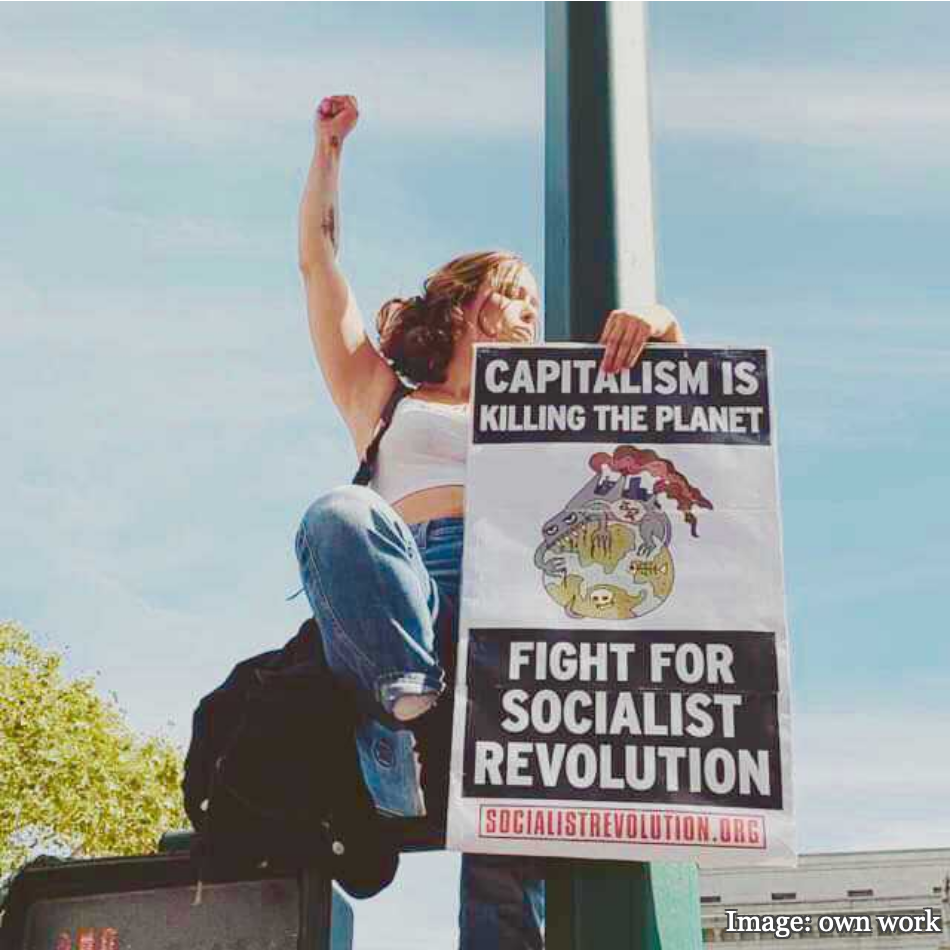 To manage our resources for the needs of people and planet alike, we need a democratic plan of production and distribution / Image: Socialist Revolution
To manage our resources for the needs of people and planet alike, we need a democratic plan of production and distribution / Image: Socialist Revolution
Companies such as this are ripe for expropriation. The sacred property of one man, means the devastation of millions of lives.
Today’s global network of agricultural companies, taken into workers’ control, would allow for agriculture's abundance to be used for all of humanity’s needs, while restoring the world’s forests, and protecting the insect population. This must be combined with a centrally planned, international network of intermodal shipping routes for effective global distribution. The monopolisation that has taken place in the shipping sector also makes the sector ripe for workers’ expropriation. Between 2000 to 2018, the 10 largest container companies increased their market share from 12% to 82%.
This type of perspective is lacking from the ideas presented in the Green New Deal, and as a result it does not match up to the demands of the crisis we find ourselves in.
The climate crisis and the coronavirus pandemic have laid bare the need for an international plan of production. The demand for the expropriation of the biggest monopolies and industries should be on the order of the day. You could not ask for more clear opportunities. But left reformism cannot help but squander these opportunities, as it cannot see beyond capitalism any more than the ruling class itself can.
In other words, the main barrier to tackling the climate crisis is not a technological one, but a political one. The only social force that can remove that barrier is the organised working class, and time is running out. The movement of the working class must therefore be armed with the correct ideas as soon as possible. The reformist illusions, even those of the left reformists, can only lead down a blind alley that we do not have time to explore again.
In 1938, Leon Trotsky wrote the following words:
“Without a socialist revolution, in the next historical period at that, a catastrophe threatens the whole culture of mankind. The turn is now to the proletariat…The historical crisis of mankind is reduced to the crisis of the revolutionary leadership.”
It was true back then, in the face of the catastrophe of WW2, a brutal imperialist slaughter. It is true now, in the face of climate catastrophe.
To manage our resources for the needs of people and planet alike, we need a democratic plan of production and distribution. The task at hand is therefore to prepare for the revolutionary events that are beginning to come thick and fast across the world; preparation for the seizure of power by the working class. This, and this alone, can throw the doors wide open, for the next great task facing us; the harmonisation of humanity with the rest of the natural world.

